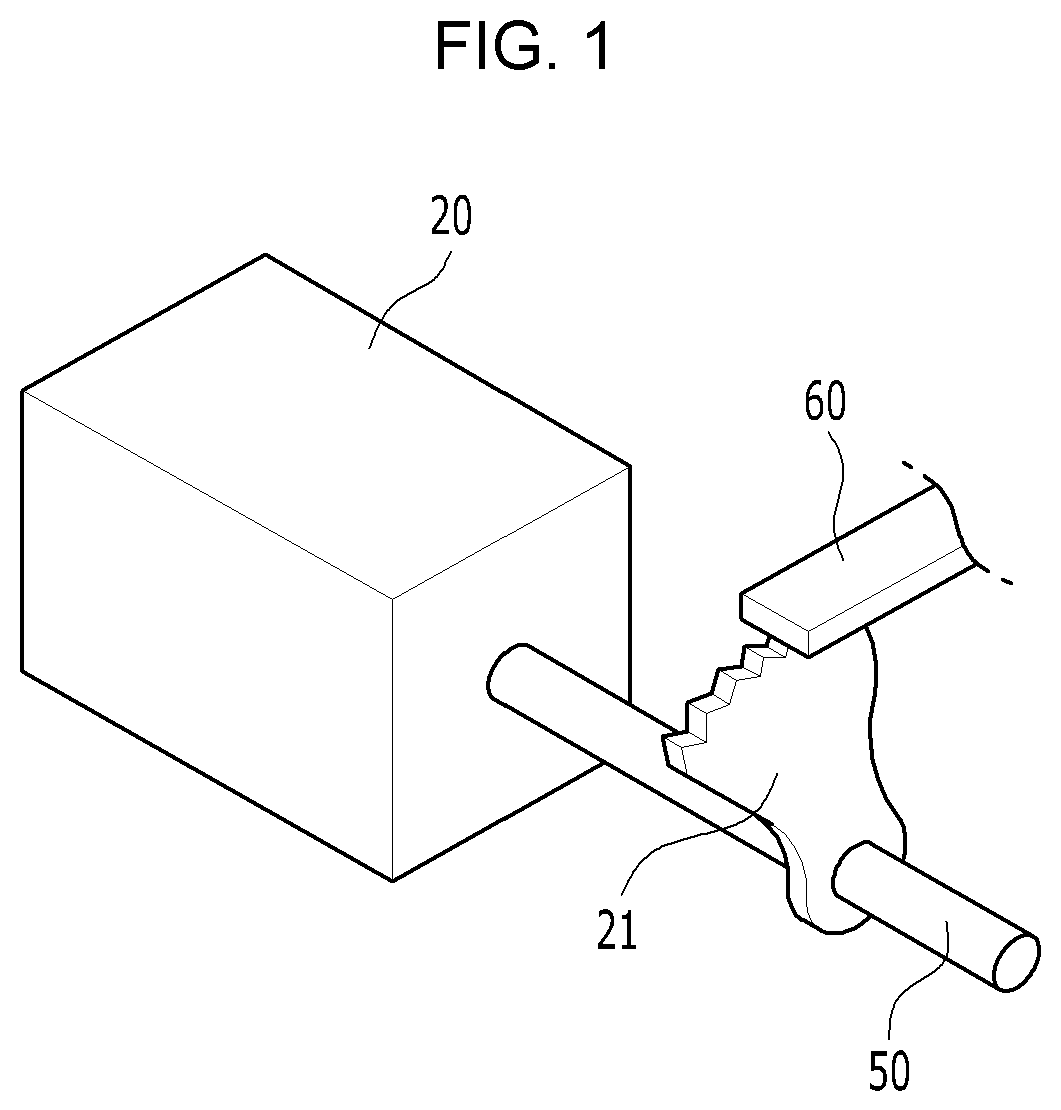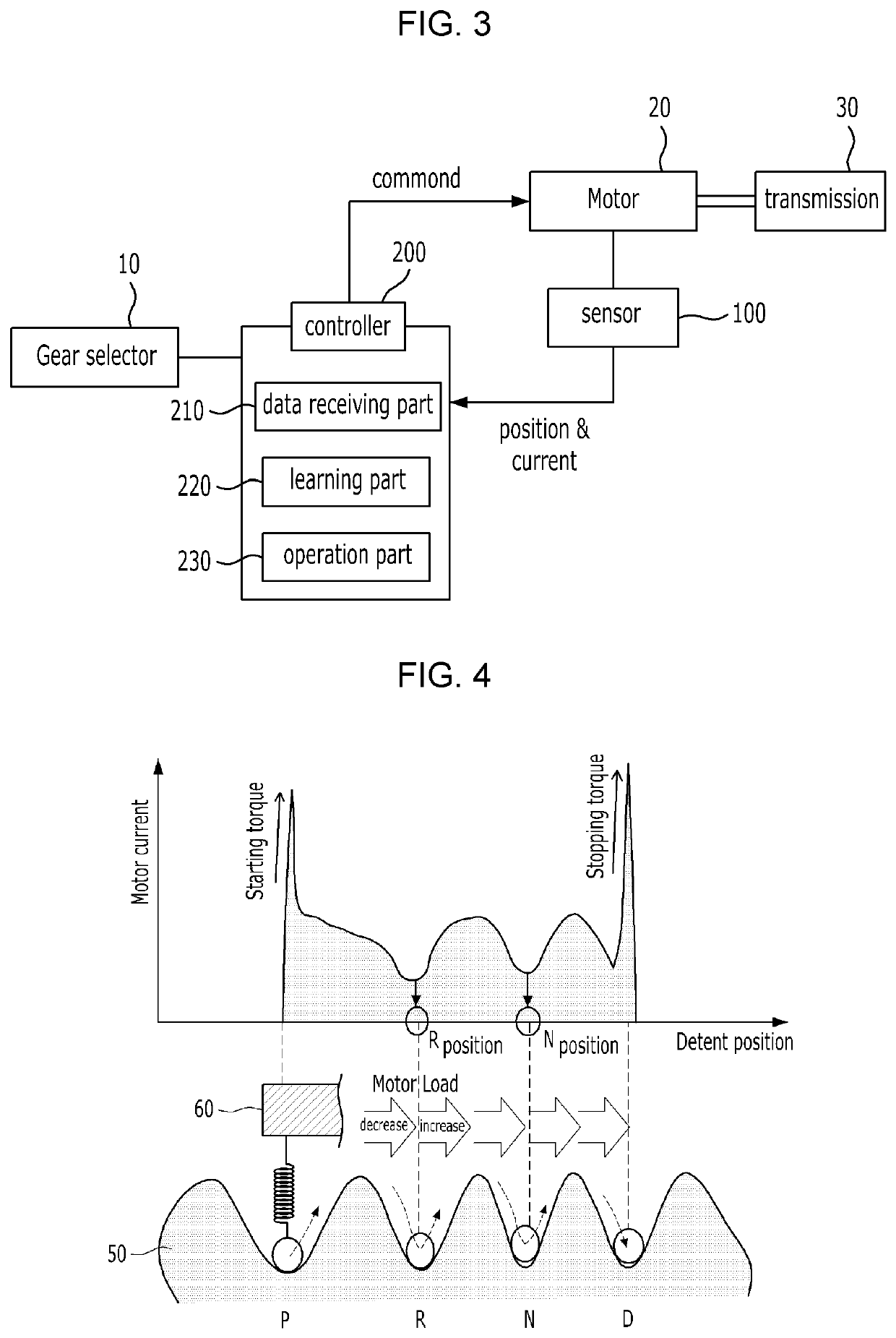Position learning system for electric shift-by-wire system
a technology of electric shift and learning system, which is applied in the direction of gearing control, gearing element, belt/chain/gearing, etc., can solve the problems of difficult hard to recognize the accurate position of the motor, and difficult to recognize the position of the motor in a simple and accurate manner
- Summary
- Abstract
- Description
- Claims
- Application Information
AI Technical Summary
Benefits of technology
Problems solved by technology
Method used
Image
Examples
first embodiment
[0043]Hereinafter, an explanation on a position learning system for an electric shift-by-wire system according to the present invention will be in detail given with reference to FIGS. 3 to 5.
[0044]FIG. 3 is a block diagram showing a position learning system for an electric shift-by-wire system according to a first embodiment of the present invention, FIG. 4 is a graph showing variations of current data according to rotation of a detent plate in the position learning system according to the first embodiment of the present invention, and FIG. 5 is a flowchart showing a process of learning positions of shift stages in the position learning system according to the first embodiment of the present invention.
[0045]The present invention relates to the position learning system for an electric shift-by-wire system that is capable of sensing changes in the load of a motor 20 according to operations of a four-stage detent plate 50 and a detent spring 60 to learn positions of shift stages of the...
second embodiment
[0061]Next, an explanation on a position learning system for an electric shift-by-wire system according to the present invention will be in detail given with reference to FIGS. 3 and 6.
[0062]FIG. 6 is a front view showing a process of learning positions of shift stages of a two-stage detent plate in a position learning system for an electric shift-by-wire system according to a second embodiment of the present invention.
[0063]According to the second embodiment of the present invention, a position learning system for an electric shift-by-wire, which senses changes in the load of a motor 20 according to operations of a two-stage detent plate 50 and a detent spring 60 and thus learns positions of shift stages, includes a sensor 100 for sensing the current generated from the motor and a controller 200 for receiving current data until a shift stage P is switched to a shift stage (hereinafter, referred to as Not P) which is not the shift stage P or the shift stage (Not P) is switched to th...
third embodiment
[0070]Lastly, an explanation on a position learning system for an electric shift-by-wire system according to the present invention will be in detail given with reference to FIGS. 3 and 7.
[0071]FIG. 7 is a flowchart showing a process of learning positions of shift stages in a position learning system for an electric shift-by-wire system according to a third embodiment of the present invention.
[0072]According to the third embodiment of the present invention, a position learning system for an electric shift-by-wire, which senses changes in the load of a motor 20 according to operations of a four-stage detent plate 50 and a detent spring 60 and thus learns positions of shift stages, includes a sensor 100 for sensing the current generated from the motor and a controller 200 for receiving current data until a shift stage P is switched to a shift stage D and the shift stage D is switched back to the shift stage P from the sensor 100, learning positions of shift stages R and N through the c...
PUM
 Login to View More
Login to View More Abstract
Description
Claims
Application Information
 Login to View More
Login to View More - R&D
- Intellectual Property
- Life Sciences
- Materials
- Tech Scout
- Unparalleled Data Quality
- Higher Quality Content
- 60% Fewer Hallucinations
Browse by: Latest US Patents, China's latest patents, Technical Efficacy Thesaurus, Application Domain, Technology Topic, Popular Technical Reports.
© 2025 PatSnap. All rights reserved.Legal|Privacy policy|Modern Slavery Act Transparency Statement|Sitemap|About US| Contact US: help@patsnap.com



